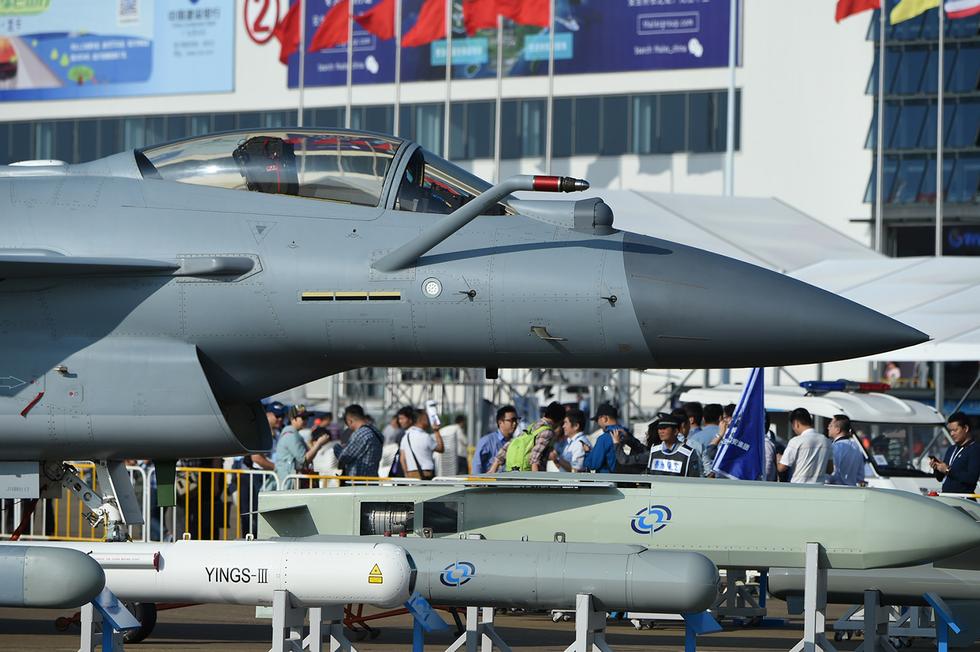2451Views

China’s scale gives flexibility for high-tech arms development
Note: This article was previously a Quwa Premium piece, it is now freely available.
On 01 February 2018 observers spotted a large cannon turret placed onboard a People’s Liberation Army Navy (PLAN) Type 072III landing ship tank (LST) along with three shipping containers aft of the cannon. Analysts took the comparatively large size of the cannon to suggest that it is an electromagnetic railgun, with the containers behind it as its electricity/power sources.[1] Conceptually, an electromagnetic railgun uses force from electromagnetic pulses to propel projectiles at high-speed and long-range.
The outcome of such technology could imbue naval platforms with the ability to assuredly cut through a modern air defence system. Not only does a hypersonic projectile drastically reduce the available reaction time available to the receiving end to intercept the munition, but there is also the energy the projectile also carries, which could significantly damage – if not completely scuttle – a surface combatant. Fruition in this technology could alter anti-ship warfare and the approach to executing stand-off range land-strikes. It would also alter how ships are armed in terms of ordnance load, i.e. the load will not require explosive propellants (found in current shells), reducing the risk of internal explosions.
In 2012, the U.S. aimed to have its own railgun program yield a solution capable of firing projectiles in-excess of Mach 5, i.e. hyper-sonic speed.[2] Although the projectile would only weigh 10 kg, the railgun can give it the energy of a 1,000 kg munition.[3] That solution – jointly undertaken by General Atomics and BAE Systems – is executing test-firings, but there is no timeline as to when a serviceable solution will be had. With China seemingly moving into that testing phase – and the added prospect of it potentially succeeding in deploying naval railguns – the U.S. and its Pacific Ocean allies will be concerned.
In contrast to most countries – with the lone, but tentative exception, of the U.S. – China has successfully been able to distribute its research and development (R&D) overhead across many production units. This ability to persistently achieve scale enables China to iterate upon existing weapons while also flexibly work for new technologies, such as railguns. The inability to achieve scale means that the sunk cost of R&D has to be distributed across fewer units, resulting in a higher actual unit-cost of the procurement.
This is exemplified in the USS Zumwalt’s Long Range Land Attack Projectile (LRLAP). The LRLAP was meant to provide the Zumwalt with a GPS-guided shell with a range of nearly 100 km. However, the U.S. Navy’s reduction of littoral combat ships (LCS) resulted in a reduced need for the Advanced Gun System which was supposed to fire the LRLAP, and in turn meant fewer required LRLAP rounds. However, the resulting (lack of) economies-of-scale pushed the unit cost of each LRLAP to $800,000.[4] With the LRLAP scrapped, the USS Zumwalt is unable to utilize one of its marquee weapons.[5]
More Analysis | A Look at How and Why Pakistan Started its Nuclear Weapons Program | Read More
This problem can potentially affect the U.S.’ own railgun development. Those efforts are tentative at best. The U.S. program under the Office of Naval Research (ONR), while fruitful in its preliminary results, could be victim to funding cuts. In fact, the U.S. Navy (USN) and ONR have decided to prioritize the development of the railgun’s hypervelocity projectiles (HPV) for use on the USN’s current naval guns ahead of railgun development.[6] Unlike the LRLAP, the HPV should have wider applicability as a result of being compatible with the USN’s existing guns, but railguns would be a substantive game-changer.
In fact, even the recent revelations from China are being received with caution. Speaking to the Financial Times, a senior engineer at the Rand Corporation – Chad Ohlandt – was skeptical that the containers aft of the cannon were enough to power the system.[7] As per Ohlandt, a railgun with an acceptable firing rate would require a large capacitor bank (i.e. a set of capacitors, each storing an electrical charge). Ohlandt noted that if the capacitor bank was in the deck of the Type 072III, then it could require potentially hours for it to recharge after a shot.[8] Thus, it is not certain that this cannon is a railgun, but even if it is, it is at best a prototype meant for testing and contributing to China’s technology development.
However, if the cannon is not on a direct track to becoming a serviceable weapon system, its testing does allude to the presence of concerted electromagnetic technology development. For China, its importance spans beyond that of railguns, but aircraft carriers as well. Retired PLAN engineer, Rear Adm. Ma Weiming is reportedly heading-up the development of an Electromagnetic Aircraft Launch System (EMALS) for the PLAN’s next-generation aircraft carrier designs.[9] Potentially seeing a railgun program demonstrates that Chinese R&D in this area is substantial enough to permeate across different applications.
In terms of deploying a railgun, it is unlikely that China will retrofit existing PLAN surface combatants, and that includes its modern designs. First, the electrical power requirements of a railgun could necessitate an all-electric propulsion and power-generation platform designed for energy-based weapons. How this can manifest is unclear. For example, the Type 055A – the follow-on to the Type 055 – destroyer is rumoured to incorporate integrated electric propulsion (IEPS).[10] However, touching upon Ohlandt’s point, it is also necessary to design the ship’s internal arrangement to favour a railgun. This could occur through sufficient space for a capacitor bank that can enable a relatively quick re-charge, for example. Basically, it is an issue of ensuring that there is sufficient power generation, storage and distribution.
To China’s credit, it is well-positioned to execute such development. By virtue of its sheer size in terms of territory, population, urban development and infrastructure construction (within and beyond China), the incentive and ability to do so is in place. China can leverage R&D and experience used for civil development for military gain. It is unlikely that China will leapfrog to an all-electric energy-weapon platform, certainly not in the near-term. However, through its aircraft carrier and next-generation surface warship and sub-surface platform development, it could gradually iterate upon its ability to design self-contained suites for power generation, storage and distribution. In parallel, its energy weapon development may increase in terms of efficiency and compactness, eventually pairing into a future frigate or destroyer.
For the U.S. and its Pacific Ocean allies, i.e. Japan, South Korea, India and Australia, the concern is not as much China’s apparent railgun development, but the entire package of development that is encompassing wide-scale industrial development towards advancing power-generation, materials, electronics and – as the railgun shows – original high-tech design work. Coupled with inherent scale at-home and a generally comfortable fiscal position in the way of cash, the next major-phase of Chinese procurement could see it induct a large number of credibly advanced systems. Despite the recent outcomes of China’s progress, as shown in the Chengdu J-20, the U.S. can still rely on a cushion of being technologically ahead.
It is premature to state that China will “pass” the U.S. in this regard. In fact, such a statement would be a grossly erroneous one that ignores the reality that the U.S. has unprecedently vast R&D depth, one that is also connected to credible works in Europe and Asia. However, the concern for the U.S. and its allies is not the quality of their respective technologies, but the question of scale and deployment. Today, China is in a position to execute the latter, which positions its high-technology efforts as less abstract and more threatening than those of the U.S. (which, unfortunately, has had its recent high-technology examples hit by controversies in the way of delays and cost-overruns, such as the F-35 and LCS). One can doubt China’s technology advances, but they cannot dispute the efficacy of its execution.
China’s procurement dynamics could impact the balance in place in the South China Seas. For the U.S., a militarily more capable China could put vital U.S. alliances in Southeast Asia at risk. It could conceivably provide Beijing the means to sustain proper alliances in that region (which affects its direct interests). It may also see some countries in the region capitalize upon Chinese technology availability, giving Beijing to exert leverage to have those countries step away from alliances with the U.S. Granted, such scenarios are relatively abstract at this time, but there is a more tangible secondary affect – i.e. proliferation.
More Analysis | Understanding Why Pakistan’s Relationship With the US is Challenging | Read More
China’s technology outcomes can come into the hands of its partners, such as Pakistan, and commercial contacts in the United Arab Emirates and Saudi Arabia. In this respect, China can plausibly alter armament dynamics in South Asia, the Middle East and Sub-Saharan Africa. Having seen strong growth in its drone exports since 2010, most notably through the Aviation Industry Corporation of China (AVIC) Wing Loong and CH-4-series of armed unmanned aerial vehicles (UAV), Beijing is fully aware of the market created as a result of a paucity of accessible – be it politically or financially – sensitive Western technology. Like UAVs, next-generation fighters and stand-off range munitions, the export of energy-weapon platforms enables China to both gain a return-on-investment from its R&D investment and to scale, thus reducing the unit-cost of this technology for its own forces.
[1] “dafeng cao” via Twitter. 01 February 2018. URL: https://twitter.com/xinfengcao/status/959054896350703616?ref_src=twsrc%5Etfw&ref_url=http%3A%2F%2Fwww.newsweek.com%2Fdid-china-build-world-first-railgun-photos-look-powerful-electromagnetic-798313 (Last Accessed: 07 February 2018).
[2] “Navy Evaluating Second Electromagnetic Railgun Innovative Naval Prototype.” Office of Naval Research. United States Navy. 09 October 2012. URL: https://www.onr.navy.mil/en/Media-Center/Press-Releases/2012/Electromagnetic-Railgun-General-Atomics-Prototype (Last Accessed: 04 February 2018).
[3] Sean Gallagher. “US dropped ball on Navy railgun development—now China is picking it up.” Ars Technica. 02 February 2018. URL: https://arstechnica.com/tech-policy/2018/02/photos-show-china-preparing-to-test-naval-railgun/ (Last Accessed: 04 February 2018).
[4] Tyle Rogoway. “The Navy Won’t Buy Ammo For Its Dumbed Down Stealth Destroyer’s Big Guns.” The Drive. 08 November 2016. URL: http://www.thedrive.com/the-war-zone/5914/the-navy-wont-buy-ammo-for-its-dumbed-down-stealth-destroyers-big-guns (Last Accessed: 04 February 2018).
[5] Ibid.
[6] Sean Gallagher. “US dropped ball on Navy railgun development—now China is picking it up.” Ars Technica. 02 February 2018. URL: https://arstechnica.com/tech-policy/2018/02/photos-show-china-preparing-to-test-naval-railgun/ (Last Accessed: 04 February 2018).
[7] Charles Clover. “China developing naval rail gun technology, say experts.” Financial Times. 07 February 2018. URL: https://www.ft.com/content/e111bfe0-0bc2-11e8-8eb7-42f857ea9f09 (Last Accessed: 08 February 2018).
[8] Ibid.
[9] Mike Yeo. “China claims breakthrough in electromagnetic launch system for aircraft carrier.” Defense News. 09 November 2017. URL: https://www.defensenews.com/naval/2017/11/09/tech-breakthrough-chinas-next-carrier-could-feature-electromagnetic-launch-system/ (Last Accessed: 04 February 2018).
[10] Deng Xiaoci. “Electromagnetic Guns Should Be Fitted on China’s New Destroyer: Experts.” Global Times. 05 February 2018. URL: http://www.globaltimes.cn/content/1088221.shtml (Last Accessed: 08 February 2018).


